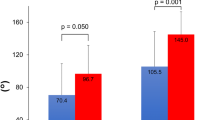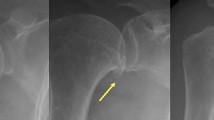Abstract
Purpose
The primary goal of this study was to investigate whether superior humeral head osteophyte (SHO) size is associated with rotator cuff insufficiency, including rotator cuff tear (RCT), supraspinatus tendon thickness, and fatty infiltration of the rotator cuff muscles.
Methods
Patients ≥ 18 years who were diagnosed with glenohumeral osteoarthritis were retrospectively reviewed. SHO size was determined by radiograph. MRI measured SHO and RCT presence, type, and size; supraspinatus tendon thickness; and fatty infiltration of rotator cuff musculature.
Results
A total of 461 patients were included. Mean SHO size was 1.93 mm on radiographs and 2.13 mm on MRI. Risk ratio for a RCT was 1.14. For each 1-mm increase in SHO size on radiograph, supraspinatus tendon thickness decreased by 0.20 mm. SHO presence was associated with moderate-to-severe fatty infiltration of the supraspinatus with a risk ratio of 3.16.
Conclusion
SHOs were not associated with RCT but were associated with higher risk of supraspinatus FI and decreased tendon thickness, which could indicate rotator cuff insufficiency.
Level of evidence
IV.




Similar content being viewed by others
Availability of data and materials
The data that support the findings of this study are not openly available due to reasons of privacy. Data are in controlled access data storage at the authors’ institutions.
References
Griffin JW, Hadeed MM, Novicoff WM, Browne JA, Brockmeier SF (2014) Patient age is a factor in early outcomes after shoulder arthroplasty. J Shoulder Elb Surg 23(12):1867–1871. https://doi.org/10.1016/j.jse.2014.04.004
Macías-Hernández SI, Morones-Alba JD, Miranda-Duarte A, Coronado-Zarco R, de LA Soria-Bastida M, Nava Bringas T, Cruz-Medina E, Olascoaga-Gómez A, Tallabs-Almazan LV, Palencia C (2017) Glenohumeral osteoarthritis: overview, therapy, and rehabilitation. Disabil Rehabilit 39(16):1674–1682. https://doi.org/10.1080/09638288.2016.1207206
Brox JI, Lereim P, Merckoll E, Finnanger AM (2003) Radiographic classification of glenohumeral arthrosis. Acta Orthop Scand 74(2):186–189. https://doi.org/10.1080/00016470310013932
Millett PJ, Schoenahl JY, Allen MJ, Motta T, Gaskill TR (2013) An association between the inferior humeral head osteophyte and teres minor fatty infiltration: evidence for axillary nerve entrapment in glenohumeral osteoarthritis. J Shoulder Elb Surg 22(2):215–221. https://doi.org/10.1016/j.jse.2012.05.030
Chalmers PN, Miller M, Wheelwright JC, Kawakami J, Henninger HB, Tashjian RZ (2021) Acromial and glenoid morphology in glenohumeral osteoarthritis: a three-dimensional analysis. JSES Int 5(3):398–405. https://doi.org/10.1016/j.jseint.2021.01.006
Koh KH, Han KY, Yoon YC, Lee SW, Yoo JC (2013) True anteroposterior (Grashey) view as a screening radiograph for further imaging study in rotator cuff tear. J Shoulder Elb Surg 22(7):901–907. https://doi.org/10.1016/j.jse.2012.09.015
Edwards TB, Boulahia A, Kempf JF, Boileau P, Nemoz C, Walch G (2002) The influence of rotator cuff disease on the results of shoulder arthroplasty for primary osteoarthritis: results of a multicenter study. J Bone Jt Surg Am 84(12):2240–2248. https://doi.org/10.2106/00004623-200212000-00018
Norris TR, Iannotti JP (2002) Functional outcome after shoulder arthroplasty for primary osteoarthritis: a multicenter study. J Shoulder Elb Surg 11(2):130–135. https://doi.org/10.1067/mse.2002.121146
Levy DM, Abrams GD, Harris JD, Bach BR Jr, Nicholson GP, Romeo AA (2016) Rotator cuff tears after total shoulder arthroplasty in primary osteoarthritis: a systematic review. Int J Shoulder Surg 10(2):78–84. https://doi.org/10.4103/0973-6042.180720
Young AA, Walch G, Pape G, Gohlke F, Favard L (2012) Secondary rotator cuff dysfunction following total shoulder arthroplasty for primary glenohumeral osteoarthritis: results of a multicenter study with more than five years of follow-up. J Bone Jt Surg Am 94:685–693. https://doi.org/10.2106/JBJS.J.00727
Bohonos CJ, Russell SP, Morrissey DI (2021) CT versus MRI planning for reverse geometry total shoulder arthroplasty. J Orthop 28:21–25. https://doi.org/10.1016/j.jor.2021.10.003
Cancienne JM, Dempsey IJ, Garrigues GE, Cole BJ, Brockmeier SF, Werner BC (2021) Trends and impact of three-dimensional preoperative imaging for anatomic total shoulder arthroplasty. Shoulder Elb 13(4):380–387. https://doi.org/10.1177/1758573220908865
Dekker TJ, Steele JR, Vinson EV, Garrigues GE (2019) Current peri-operative imaging concepts surrounding shoulder arthroplasty. Skelet Radiol 48(10):1485–1497. https://doi.org/10.1007/s00256-019-03183-3
Alolabi B, Youderian AR, Napolitano L, Szerlip BW, Evans PJ, Nowinski RJ, Ricchetti ET, Iannotti JP (2014) Radiographic assessment of prosthetic humeral head size after anatomic shoulder arthroplasty. J Shoulder Elb Surg 23(11):1740–1746. https://doi.org/10.1016/j.jse.2014.02.013
Fuchs B, Weishaupt D, Zanetti M, Hodler J, Gerber C (1999) Fatty degeneration of the muscles of the rotator cuff: assessment by computed tomography versus magnetic resonance imaging. J Shoulder Elb Surg 8(6):599–605. https://doi.org/10.1016/s1058-2746(99)90097-6
Doğan NÖ (2018) Bland-Altman analysis: a paradigm to understand correlation and agreement. Turk J Emerg Med 18(4):139–141. https://doi.org/10.1016/j.tjem.2018.09.001
Moran GW (1984) Locally-Weighted-Regression Scatter-Plot Smoothing (LOWESS): a graphical exploratory data analysis technique. Naval Postgraduate School, Monterey
Pearsall AW, Bonsell S, Heitman RJ, Helms CA, Osbahr D, Speer KP (2003) Radiographic findings associated with symptomatic rotator cuff tears. J Shoulder Elb Surg 12(2):122–127. https://doi.org/10.1067/mse.2003.19
Chuang H-C, Hong C-K, Hsu K-L, Kuan F-C, Chiang C-H, Chen Y, Su W-R (2020) Radiographic greater tuberosity spurs and narrow acromiohumeral intervals are associated with advanced retraction of the supraspinatus tendon in patients with symptomatic rotator cuff tears. JSES Int 5(1):77–82. https://doi.org/10.1016/j.jseint.2020.09.015
Chuang H-C, Hong C-K, Hsu K-L, Kuan F-C, Lin C-L, Su W-R (2019) The radiographic morphology of the greater tuberosity is associated with muscle degeneration in patients with symptomatic rotator cuff tears. J Shoulder Elb Surg 28(10):1964–1970. https://doi.org/10.1016/j.jse.2019.03.010
Hamid N, Omid R, Yamaguchi K, Steger-May K, Stobbs G, Keener JD (2012) Relationship of radiographic acromial characteristics and rotator cuff disease: a prospective investigation of clinical, radiographic, and sonographic findings. J Shoulder Elb Surg 21(10):1289–1298. https://doi.org/10.1016/j.jse.2011.09.028
Sayed-Noor AS, Pollock R, Elhassan BT, Kadum B (2018) Fatty infiltration and muscle atrophy of the rotator cuff in stemless total shoulder arthroplasty: a prospective cohort study. J Shoulder Elb Surg 27(6):976–982. https://doi.org/10.1016/j.jse.2017.12.021
Moineau G, McClelland WB, Trojani C, Rumian A, Walch G, Boileau P (2012) Prognostic factors and limitation of anatomic shoulder arthroplasty for the treatment of posttraumatic cephalic collapse or necrosis (type-1 proximal humeral fracture sequelae). J Bone Jt Surg Am 94(23):2186–2194. https://doi.org/10.2106/JBJS.J.00412
Edwards GA, McCann PA, Whitehouse MR, Wakeley CJ, Sarangi PP (2020) The influence of fatty infiltration and muscle atrophy of the rotator cuff muscles on midterm functional outcomes in total shoulder resurfacing at six years follow up. Shoulder Elb 12(2):91–98. https://doi.org/10.1177/1758573218811655
Lapner PLC, Jiang L, Zhang T, Athwal GS (2015) Rotator cuff fatty infiltration and atrophy are associated with functional outcomes in anatomic shoulder arthroplasty. Clin Orthop Relat Res 473(2):674–682. https://doi.org/10.1007/s11999-014-3963-5
Author information
Authors and Affiliations
Corresponding author
Ethics declarations
Conflict of interest
The authors did not receive support from any organization for the supported work. The authors report no conflicts of interest.
Ethical approval
This study was approved by the Institutional Review Board of the University of Tennessee Health Science College and complies with all applicable laws and ethical standards.
Additional information
Publisher's Note
Springer Nature remains neutral with regard to jurisdictional claims in published maps and institutional affiliations.
Rights and permissions
Springer Nature or its licensor (e.g. a society or other partner) holds exclusive rights to this article under a publishing agreement with the author(s) or other rightsholder(s); author self-archiving of the accepted manuscript version of this article is solely governed by the terms of such publishing agreement and applicable law.
About this article
Cite this article
Jennewine, B.R., James, N.F., Polio, W.P. et al. Superior humeral head osteophytes are associated with rotator cuff insufficiency in glenohumeral osteoarthritis: a retrospective analysis. Eur J Orthop Surg Traumatol 34, 893–900 (2024). https://doi.org/10.1007/s00590-023-03727-3
Received:
Accepted:
Published:
Issue Date:
DOI: https://doi.org/10.1007/s00590-023-03727-3




